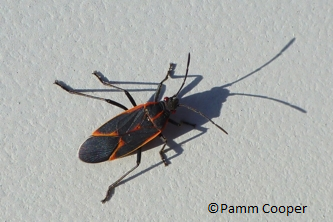Boxelder Bug (Boisea trivittata)
Boxelder bugs often become pests when large numbers of them appear in houses or congregate on the sunny sides of buildings in the fall, late winter and early spring. Although there are reports that they bite people, this is apparently very rare. They do not damage buildings, furniture, clothing or food, but can spot curtains and walls with fecal material and produce a foul odor when crushed. Therefore, they are principally a nuisance because of their presence, especially when they crawl or fly about rooms.
Description

Adult boxelder bugs are about 1/2" long, dark brown to black with conspicuous red markings on their backs. They are flat and their wings overlap on their backs. The young or nymphs are wingless but generally similar in shape to the adults. The smaller nymphs are solid bright red, but the older nymphs have some black markings. They molt five times to become adults. Males and females look alike.
Host Plants
Boxelder bugs are especially numerous where seed-bearing or female boxelder trees (also known as ash-leaf or three-leaf maple) are found. Not surprisingly, the female boxelder tree is the preferred host of these insects. Although boxelder bugs will occasionally feed on ash, maple, plum, cherry, peach, pear, grape plus other trees, shrubs and grasses, they do not appear to build up to nuisance numbers unless they feed on boxelder trees.
Life Cycle
In the fall swarms of boxelder bugs may be seen on the trunks of trees and on the south side of buildings. At this time, they begin to migrate into sheltered places to pass the winter. They select such locations as various cracks and crevices, hollow tree trunks, litter and trash piles, barns, other outbuildings and homes. They hide in wall voids, door and window casings, under shingles and shutters, in attics and basements, around foundations and whatever other protected spots they can find. They remain in these locations during the evenings in cool weather but resume activity during sunny, warm days of fall.
Activity ceases during most of the winter, but the bugs may appear for brief periods during sunny, warm days in late winter and early spring, especially on house siding or on windows of rooms with a southern exposure or sometimes in the rooms themselves. They have even been reported on snow.
In the spring when buds appear, the bugs leave their winter quarters and seek host plants on which to lay their eggs. The females lay tiny, rusty-red, oval eggs in bark crevices, on leaves and other parts of female boxelder trees. They will also lay their eggs on other trees as well as on grass, litter, fences, stones and other places.
The young bugs or nymphs hatch in about two weeks and feed by inserting their beaks and sucking the plant juices of leaves, fruits and soft seeds. Their feeding causes little injury to boxelder trees but may result in the dimpling of some tree fruits. They continue to feed through the season and become adults in late summer and early fall. The onset of cool weather signals the start of their migration to winter quarters.
Control
Host Removal
The most satisfactory and permanent method of control where boxelder bugs are a recurring problem, is the removal of nearby seed-bearing or female boxelder trees. This is not always a practical solution, however, if nearby boxelders are not on your property. In addition, the trees may be located quite far away; it is known that boxelder bugs can migrate for considerable distances.
Chemical Control
Boxelder bugs are difficult to control outdoors with insecticides under any circumstances. This is mostly a result of the fact that the effectiveness of most insecticides is directly related to temperature. The warmer it is the more effective they are; the cooler it is, the less effective they are. This increase or decrease in effectiveness pivots at around 70oF. Unfortunately, boxelder bugs tend to be nuisances when temperatures are normally much lower than 70oF. In addition, the insecticide residues do not last for much more than a week.
Spraying Infested Outdoor Premises
As boxelder bugs mature, they leave their host trees and usually mass at the bases of these and other trees, along fence rows, around foundation walls and other places. Insecticides are most effective when applied directly on the bugs, but they can also be relatively effective if enough spray is applied to thoroughly wet all surfaces over which the bugs crawl. Several gallons of spray are generally required. When treating the foundation, spray thoroughly up into the area where the siding overhangs the foundations, into all cracks and crevices along breezeways and patios, and around all windows and door frames and hatchways up to about three feet above the ground.
Indoor Preventative Treatment
It is very useful to prevent entry into homes by applying caulking compound around lower window and door frames as well as other cracks and crevices around the foundation and siding within about three feet of the ground.
Indoor control can be had by daily vacuuming and prompt disposal of the contents of the cleaner bag. Or store the vacuum bag in a plastic bag in the freezer until next use.
Despite good cultural practices, pests and diseases at times may appear. Chemical control should be used only after all other methods have failed. For pesticide information please call UConn Home and Garden Education Center or your local cooperative extension office.
The UConn Home & Garden Education Center supports UConn Extension’s mission by providing answers you can trust with research-based information and resources. For gardening questions, contact us toll-free at (877) 486-6271, visit our website at homegarden.cahnr.uconn.edu, or reach out to your local UConn Extension center at cahnr.uconn.edu/extension/locations.
Revised by UConn Home and Garden Education Center 2019.